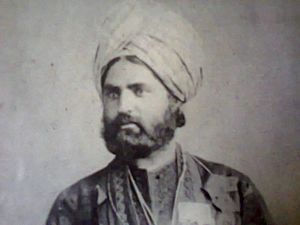Muhammad Hayat Khan facts for kids
Quick facts for kids
Muhammad Hayat Khan Khattar
CSI
|
|
|---|---|

Nawab Muhammad Hayat Khan circa 1860s
|
|
Nawab Muhammad Hayat Khan Khattar CSI (1833–1901) was an important Punjabi Muslim leader. He worked for the British government in British India and became very well-known for his service.
Early Life and Adventures
Muhammad Hayat Khan was born in 1833 in a village called Wah in Punjab. His father, Sardar Karam Khan, was a local leader.
When Muhammad was young, his father became friends with British officers from the East India Company. This company was a powerful British trading group that also governed parts of India.
In 1848, a group of Sikh soldiers rebelled. Muhammad Hayat Khan, even as a young man, joined a British officer named John Nicholson on a mission. They went to the Margalla Hills to capture a tower near Taxila. During the fight, Muhammad Hayat Khan bravely rescued Nicholson when he was in danger. After this, Nicholson and Karam Khan became close friends.
Later that year, Muhammad's father, Karam Khan, was sadly killed by his half-brother. Muhammad, his mother, and his siblings had to leave their home. They found safety in the Hazara region. There, they met another British officer, James Abbott. Abbott helped them connect with John Nicholson, who made sure the family got their land back and that Muhammad and his siblings could go to school.
A Career in Service
After getting a good education, especially learning Persian, young Muhammad Hayat started working for John Nicholson. He became Nicholson's helper and interpreter, translating Persian for him. He stayed by Nicholson's side during many campaigns in Punjab and the frontier areas.
In 1857, a big rebellion happened in India, sometimes called the Indian Mutiny. John Nicholson was badly hurt during a battle in Delhi. Muhammad Hayat Khan stayed with him for his last days. It is said that Nicholson, before he died, asked Sir John Lawrence, a top British official, to help Muhammad Hayat Khan with his future career. This was the start of Muhammad Hayat Khan's long and successful journey.
Soon after the rebellion, he became a police officer in Talagang. He then moved into civil administration as a junior officer. In 1862, he was promoted and sent to Bannu and Kohat.
In 1864, he went on a special trip to Afghanistan. That same year, he wrote a famous book called Hyat i Afghan (which means "Afghanistan and its Inhabitants"). He wrote it in Urdu and also translated it into Persian. This book is still considered one of the best works about Afghanistan.
In 1872, Muhammad Hayat Khan was promoted again. Because of his excellent work, he received a special honor called the Companion of the Order of the Star of India (CSI). He also worked as a political agent in the Kurram Agency. During the Second Anglo-Afghan War, he was a key helper for General Sir Frederick Roberts.
After the war, he continued his work in Punjab's administration. He later became a judge, serving in different places between 1880 and 1888. He also became a member of the Punjab Board of Revenue, which managed land taxes. In 1897, he was chosen to represent Muslim landowners in the Punjab Legislative Council, a governing body.
In 1899, he was given the special title of Nawab. This was to honor his many years of outstanding service. Nawab Muhammad Hayat Khan passed away in his home village of Wah in 1901.
Supporting Education
Muhammad Hayat Khan was a very close friend of Sir Syed Ahmad Khan, a famous Muslim thinker and reformer who worked to improve education. Muhammad Hayat Khan actively helped Sir Syed establish the Muhammadan Anglo-Oriental College at Aligarh, which later became Aligarh Muslim University. He even led the annual meetings of the 'Muhammadan Educational Conference' several times.
He also worked hard to help Muslims in his home province of Punjab. He was one of the first important people in Punjab to donate money for the new University College, Punjab (which later became the University of the Punjab) in 1870.
Family Legacy
Nawab Muhammad Hayat Khan had many children. Two of his sons, Nawab Sir Liaqat Hyat Khan (born 1887) and Sir Sikandar Hyat Khan (born 1892), became very famous and important figures in their own right.

